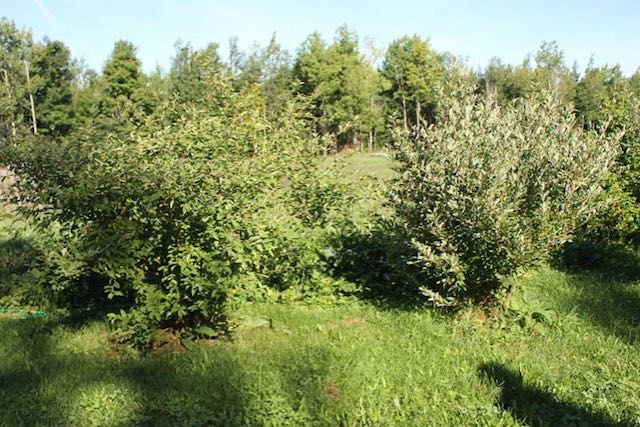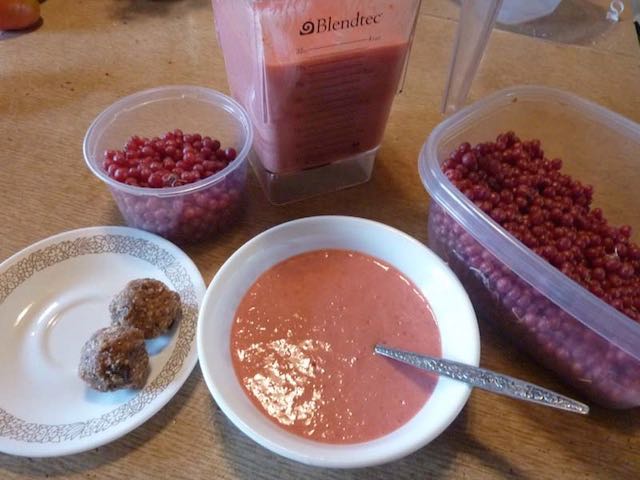Gardening
Goumi Berries
10/17/13 03:15 PM
Just had to share how pleased I am with our goumi bushes. The goumi is a relative of the cardinal autumn olive, which in some areas is considered an invasive pest. It's a beautiful nitrogen fixing bush, extracting nitrogen from the air and fixing it in the soil surrounding the plant through special bacteria in its roots. It's a favorite of permaculture/biodynamic/forest gardeners. I bought 10 small bushes 3 years ago for only $25 (it's hard to find such a deal these days, and I notice that my original source no longer supplies them), and they quickly grew into these beauties:
While they produced a few berries last year, which my then 9 yr old son proclaimed to be delicious, this is the first year of true bounty. The fun part about these berries is that they're ripening when everything else is dying off, and for those of us who like to snack while we garden, that's extremely important. Some of us enjoy big handfuls of these whenever we pass by (others wrinkle their noses at their tartness/astringency, which they say goes away when they're fully ripe). Perhaps ours aren't fully there yet, but we're enjoying them anyway, as are the birds, which seem particularly plentiful this year.
No one has to tell me that these have special nutrients that my body is craving, as I can sense the antioxidants and essential fatty acids, especially when blended into the creamiest ever kefir yogurt. There must be some polysaccharides in these babies, as something is turning this kefir into a smooth, delicious treat. Mixed with a handful of frozen strawberries, a scoop of honey and a tsp of konjac (not really necessary, as the goumi berries thicken this up nicely), this is the tastiest yogurt ever, and quite possibly the prettiest (ok, it's a little rustic in that there are some small fibers from the seeds, the pickier amongst us will sieve this before serving, but I like a little extra fiber).
So there you have it, an inexpensive, easy to grow, beautiful, life giving and productive bush to grace the homestead!

While they produced a few berries last year, which my then 9 yr old son proclaimed to be delicious, this is the first year of true bounty. The fun part about these berries is that they're ripening when everything else is dying off, and for those of us who like to snack while we garden, that's extremely important. Some of us enjoy big handfuls of these whenever we pass by (others wrinkle their noses at their tartness/astringency, which they say goes away when they're fully ripe). Perhaps ours aren't fully there yet, but we're enjoying them anyway, as are the birds, which seem particularly plentiful this year.
No one has to tell me that these have special nutrients that my body is craving, as I can sense the antioxidants and essential fatty acids, especially when blended into the creamiest ever kefir yogurt. There must be some polysaccharides in these babies, as something is turning this kefir into a smooth, delicious treat. Mixed with a handful of frozen strawberries, a scoop of honey and a tsp of konjac (not really necessary, as the goumi berries thicken this up nicely), this is the tastiest yogurt ever, and quite possibly the prettiest (ok, it's a little rustic in that there are some small fibers from the seeds, the pickier amongst us will sieve this before serving, but I like a little extra fiber).
So there you have it, an inexpensive, easy to grow, beautiful, life giving and productive bush to grace the homestead!

Comments
EM's for the Garden, Russian style
02/24/13 03:21 PM
My last post was an update on our experience with EM's (efficient microbes) on our homestead.
In Russia, the term "EM's" has come into common use to describe homemade brews made to enhance soil fertility. A recipe for such a brew is offered in the book "Growing Vegetables with a Smile:"
50 gal water
lb of any compound fertilizer containing trace elements or, even better, 1/2 gl of dried bird droppings
1/2 bucket of compost
1/2 bucket of rotted straw
Fresh grass and leaves, if desired
1 c ashes or lime
2 lb of sugar
2 buckets of rotting fruit (or some 2 qts of old preserves)
Pinch of any kind of yeast
Ready in about a week (yeast is multiplied but not yet died out). At this point, a liter of curdled milk can be added for extra lactic acid. The resulting concoction is full of nutrients, microbes and stimulators. Watering with this brew invigorates plants and has a long lasting effect.
Want an easier and just as effective method?
1/2 c. of sugar or a c. of old preserves
3 qt water
pinch of baker's yeast
3-4 days, brew is flourishing. One c. of brew to bucket of water, once a week on seedlings and transplants and twice a month on adult plants. In a test, young plants developed nearly 2 times faster than those treated with EM and other store-bought stimulators.
"In general, the more beneficial ingredients are combined, the better. Mix together greens, comp;oat, half a dose of a chelate fertilizer, some form of sugar, lactic acid bacteria, and yeast, and you will get an effective and unequivocally harmless infusion. You could even call it the "drink of the gods" - nectar and ambrosia for plants. But even such "Herbalife" works only when it can penetrate the soil under stable moisture conditions. Otherwise, the microbes will die."
I will add my 2 cents to this method, and suggest that a person may want to consider adding some mycorrhizal fungi to the brew. Mycorrhizal fungi are mushroom species which enhance the growth of plants by helping to deliver nutrients and water to their roots. Fungi, like other beneficial bacteria, get destroyed by any invasive or abrupt action on the soil, such as tilling, chemical fertilizers, flooding, and leaving soil bare.
The spores are present on all parts of a mushroom, and multiply when cultured on sweet, just like yeasts do, so adding pieces of mushrooms or spore powder to your brews will help your gardens grow, and if you want to take the care to learn your mushrooms, you can do this with species that are also edible and enjoy extra fruit from your garden's fertilizer.
You can read more about mycorrhizal fungi and even purchase some spores to add to your brews here.
I will discuss the mycorrzial mushrooms that we cultivate in our garden area in a future post.
Think SPRING!
In Russia, the term "EM's" has come into common use to describe homemade brews made to enhance soil fertility. A recipe for such a brew is offered in the book "Growing Vegetables with a Smile:"
50 gal water
lb of any compound fertilizer containing trace elements or, even better, 1/2 gl of dried bird droppings
1/2 bucket of compost
1/2 bucket of rotted straw
Fresh grass and leaves, if desired
1 c ashes or lime
2 lb of sugar
2 buckets of rotting fruit (or some 2 qts of old preserves)
Pinch of any kind of yeast
Ready in about a week (yeast is multiplied but not yet died out). At this point, a liter of curdled milk can be added for extra lactic acid. The resulting concoction is full of nutrients, microbes and stimulators. Watering with this brew invigorates plants and has a long lasting effect.
Want an easier and just as effective method?
1/2 c. of sugar or a c. of old preserves
3 qt water
pinch of baker's yeast
3-4 days, brew is flourishing. One c. of brew to bucket of water, once a week on seedlings and transplants and twice a month on adult plants. In a test, young plants developed nearly 2 times faster than those treated with EM and other store-bought stimulators.
"In general, the more beneficial ingredients are combined, the better. Mix together greens, comp;oat, half a dose of a chelate fertilizer, some form of sugar, lactic acid bacteria, and yeast, and you will get an effective and unequivocally harmless infusion. You could even call it the "drink of the gods" - nectar and ambrosia for plants. But even such "Herbalife" works only when it can penetrate the soil under stable moisture conditions. Otherwise, the microbes will die."
I will add my 2 cents to this method, and suggest that a person may want to consider adding some mycorrhizal fungi to the brew. Mycorrhizal fungi are mushroom species which enhance the growth of plants by helping to deliver nutrients and water to their roots. Fungi, like other beneficial bacteria, get destroyed by any invasive or abrupt action on the soil, such as tilling, chemical fertilizers, flooding, and leaving soil bare.
The spores are present on all parts of a mushroom, and multiply when cultured on sweet, just like yeasts do, so adding pieces of mushrooms or spore powder to your brews will help your gardens grow, and if you want to take the care to learn your mushrooms, you can do this with species that are also edible and enjoy extra fruit from your garden's fertilizer.
You can read more about mycorrhizal fungi and even purchase some spores to add to your brews here.
I will discuss the mycorrzial mushrooms that we cultivate in our garden area in a future post.
Think SPRING!